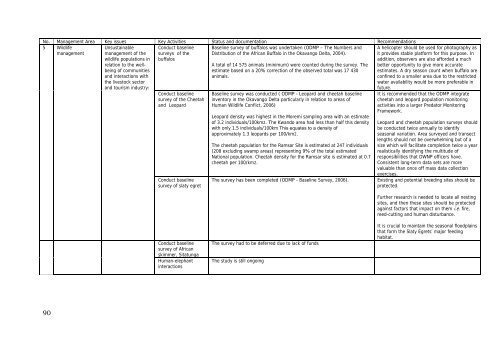Okavango Delta Management Plan - Ramsar Convention on Wetlands
Okavango Delta Management Plan - Ramsar Convention on Wetlands
Okavango Delta Management Plan - Ramsar Convention on Wetlands
You also want an ePaper? Increase the reach of your titles
YUMPU automatically turns print PDFs into web optimized ePapers that Google loves.
No. <str<strong>on</strong>g>Management</str<strong>on</strong>g> Area Key issues Key Activities Status and documentati<strong>on</strong> Recommendati<strong>on</strong>s<br />
5 Wildlife<br />
management<br />
90<br />
Unsustainable<br />
management of the<br />
wildlife populati<strong>on</strong>s in<br />
relati<strong>on</strong> to the wellbeing<br />
of communities<br />
and interacti<strong>on</strong>s with<br />
the livestock sector<br />
and tourism industry:<br />
C<strong>on</strong>duct baseline<br />
surveys of the<br />
buffalos<br />
C<strong>on</strong>duct baseline<br />
survey of the Cheetah<br />
and Leopard<br />
C<strong>on</strong>duct baseline<br />
survey of slaty egret<br />
C<strong>on</strong>duct baseline<br />
survey of African<br />
skimmer, Sitatunga<br />
Human-elephant<br />
interacti<strong>on</strong>s<br />
Baseline survey of buffalos was undertaken (ODMP – The Numbers and<br />
Distributi<strong>on</strong> of the African Buffalo in the <str<strong>on</strong>g>Okavango</str<strong>on</strong>g> <str<strong>on</strong>g>Delta</str<strong>on</strong>g>, 2004).<br />
A total of 14 575 animals (minimum) were counted during the survey. The<br />
estimate based <strong>on</strong> a 20% correcti<strong>on</strong> of the observed total was 17 430<br />
animals.<br />
Baseline survey was c<strong>on</strong>ducted ( ODMP - Leopard and cheetah baseline<br />
inventory in the <str<strong>on</strong>g>Okavango</str<strong>on</strong>g> <str<strong>on</strong>g>Delta</str<strong>on</strong>g> particularly in relati<strong>on</strong> to areas of<br />
Human Wildlife C<strong>on</strong>flict, 2006)<br />
Leopard density was highest in the Moremi sampling area with an estimate<br />
of 3.2 individuals/100km2. The Kwando area had less than half this density<br />
with <strong>on</strong>ly 1.5 individuals/100km This equates to a density of<br />
approximately 1.3 leopards per 100/km2.<br />
The cheetah populati<strong>on</strong> for the <str<strong>on</strong>g>Ramsar</str<strong>on</strong>g> Site is estimated at 247 individuals<br />
(208 excluding swamp areas) representing 9% of the total estimated<br />
Nati<strong>on</strong>al populati<strong>on</strong>. Cheetah density for the <str<strong>on</strong>g>Ramsar</str<strong>on</strong>g> site is estimated at 0.7<br />
cheetah per 100/km2.<br />
A helicopter should be used for photography as<br />
it provides stable platform for this purpose. In<br />
additi<strong>on</strong>, observers are also afforded a much<br />
better opportunity to give more accurate<br />
estimates. A dry seas<strong>on</strong> count when buffalo are<br />
c<strong>on</strong>fined to a smaller area due to the restricted<br />
water availability would be more preferable in<br />
future.<br />
It is recommended that the ODMP integrate<br />
cheetah and leopard populati<strong>on</strong> m<strong>on</strong>itoring<br />
activities into a larger Predator M<strong>on</strong>itoring<br />
Framework.<br />
Leopard and cheetah populati<strong>on</strong> surveys should<br />
be c<strong>on</strong>ducted twice annually to identify<br />
seas<strong>on</strong>al variati<strong>on</strong>. Area surveyed and transect<br />
lengths should not be overwhelming but of a<br />
size which will facilitate completi<strong>on</strong> twice a year<br />
realistically identifying the multitude of<br />
resp<strong>on</strong>sibilities that DWNP officers have.<br />
C<strong>on</strong>sistent l<strong>on</strong>g-term data sets are more<br />
valuable than <strong>on</strong>ce off mass data collecti<strong>on</strong><br />
exercises.<br />
The survey has been completed (ODMP - Baseline Survey, 2006). Existing and potential breeding sites should be<br />
protected.<br />
The survey had to be deferred due to lack of funds<br />
The study is still <strong>on</strong>going<br />
Further research is needed to locate all nesting<br />
sites, and then these sites should be protected<br />
against factors that impact <strong>on</strong> them i.e. fire,<br />
reed-cutting and human disturbance.<br />
It is crucial to maintain the seas<strong>on</strong>al floodplains<br />
that form the Slaty Egrets’ major feeding<br />
habitat.

















